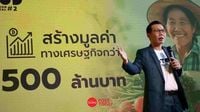In a world increasingly shaped by economic shifts and technological advancements, the concept of globalization has evolved significantly over the decades. The transition from Globalization 1.0 to Globalization 3.0 marks a pivotal moment in how nations interact economically and strategically. According to a recent report by the Wealth Research team at Bualuang Securities, this evolution is not merely a trend of deglobalization, as often perceived, but rather a restructuring towards a more complex and resilient economic framework.
The report outlines the historical context of globalization, beginning with Globalization 1.0, which emerged in the late Cold War era when neoliberal policies allowed capital to flow freely across borders. This period saw multinational corporations (MNCs) expanding their production bases overseas to capitalize on lower labor costs, leading to the development of global supply chains focused primarily on efficiency.
During the 1980s, countries like Thailand and other emerging markets benefited significantly from foreign direct investment (FDI). Data from the World Bank reveals that by the end of the 1980s, FDI as a percentage of GDP in Thailand rose to 2.5%, a substantial increase from just 0.6% in the 1970s. The flow of global FDI surged dramatically, averaging 34% growth per year from 1990 to 1997, and further escalating to nearly 48% annually between 1998 and 2000, peaking at a staggering $1.49 trillion in 2000. This growth was largely driven by cross-border mergers and acquisitions (M&A) within emerging markets.
However, as the 21st century unfolded, significant global events began to challenge the existing economic paradigm. The 2008 Subprime Crisis and the escalating trade conflict between China and the United States in 2018 prompted a reevaluation of the vulnerabilities associated with extensive global supply chains. The geopolitical tensions, rapid technological changes, and concerns over supply chain security catalyzed a shift towards what is being termed Globalization 2.0, which emphasizes resilience and adaptability.
Strategies such as the China+1 strategy, which encourages diversification of supply chains away from China, alongside nearshoring and friend-shoring, have become increasingly popular as companies seek to mitigate risks associated with global disruptions. This shift reflects a growing recognition that the previous model of globalization was not sustainable in the face of unforeseen crises.
As the world navigates these changes, the question arises: Are we truly entering an era of deglobalization? Many experts argue that while the dynamics of international investment and trade are indeed evolving, this does not necessarily equate to a complete retreat from globalization. Rather, it is a transformation towards a new structure that is more strategic and complex.
In parallel with these global economic trends, the Digital Economy Promotion Agency (DEPA) in Thailand has launched the OTOD#2 project, aimed at revolutionizing traditional agriculture through digital technologies. Set to roll out in 2025, this initiative builds on last year’s efforts to enhance digital skills among farmers and community enterprises.
DEPA’s Director-General, Nattapol Nimmana-pacharin, stated that the OTOD#2 project is designed to promote digital agriculture by integrating technologies such as drones, smart tractors, and IoT devices. This initiative aims to improve productivity, reduce costs, and enhance the quality of agricultural products. The project is expected to generate an economic value of over 500 million baht annually.
The OTOD#2 project emphasizes community engagement, encouraging local farmers to adopt digital technologies tailored to their specific needs. By focusing on practical applications of technology, the initiative seeks to empower communities to enhance their agricultural practices sustainably.
Additionally, DEPA has signed a Memorandum of Understanding (MoU) with the Winrock International Institute for Agricultural Development (WINROCK) to promote the use of agricultural technology, further emphasizing the importance of collaboration in advancing digital agriculture.
Support for the project comes from key partners, including HG Robotics, Siam Kubota, and Chia Tai, which will provide essential resources and expertise to facilitate the adoption of these technologies in agriculture.
As part of the initiative, DEPA is organizing a Digital Agriculture Final Pitching Day, where 250 participants will present their innovative ideas for community development using digital technology. The best projects will receive funding, with awards of up to 150,000 baht for community projects and 200,000 baht for agricultural startups, amounting to a total investment of 47.5 million baht.
The OTOD#2 project represents a significant step towards modernizing Thailand’s agricultural sector, showcasing how digital transformation can enhance traditional practices. As the world grapples with the implications of globalization and its evolution, initiatives like OTOD#2 illustrate the potential for technology to drive economic growth and resilience at the community level.
In conclusion, as globalization continues to evolve, it is crucial to recognize the opportunities presented by digital technologies and the need for adaptive strategies in both economic and agricultural sectors. The journey from Globalization 1.0 to 3.0 may not signify an end to globalization, but rather a new beginning that prioritizes resilience and community empowerment.




